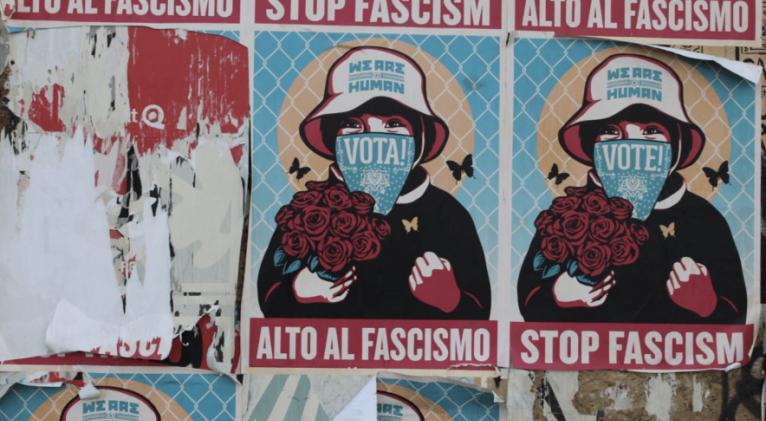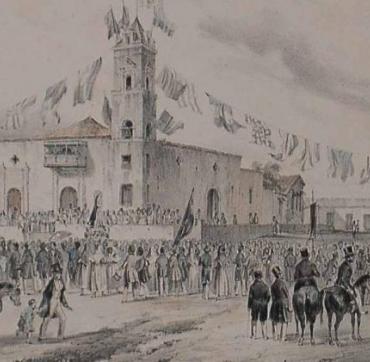History and the Plague of Fascism
especiales

Introduction
On October 24, 1970, in writing for the Amsterdam weekly Vrij Nederland, Dutch journalist and Trotskyite Igor Cornelissen (1935–2021), known for his cutting-edge surveys of the Second World War, communism, and the history of leftist movements in the Netherlands, wrote a series of book reviews on leading works analyzing a renewed fascist epidemic. Cornelissen, editor of Vrij Nederland from 1962–1996, was also a member of the Fourth International until 1971. His work as a historian of Dutch radicalism and his close examinations of figures linked to communism drew him to analyze these eight seminal works to better understand fascism in the context of the political unrest of the late 1960s and early 1970s.
The Nature of Fascism
Cornelissen first examined The Nature of Fascism, edited by S.J. Woolf and published by Vintage Books in 1969. This anthology compiles academic papers from a 1967 graduate symposium at the University of Reading, offering an interdisciplinary assessment of fascism across Europe. In his 1970 review for The New York Review of Books, Leonard Shapiro critiqued the conference for relying on vague concepts rather than concrete historical study, quoting de Maistre: “listen to the voice of history.”
Shapiro criticized attempts to define fascism as the final stage of capitalism, arguing that historical realities often transcended ideological generalizations. He singled out Timothy Wright Mason’s writings on Nazi Germany for their accuracy. Cornelissen highlighted two key questions: “Who supported National Socialists?” and “Could Hitler’s seizure of power have been prevented, and by whom?” He concluded that only the German Workers’ Movement (1918–1928) was stronger than the NSDAP. The Nature of Fascism remains a noteworthy text in fascism historiography.
The Nature of Fascism, U.K. Edition, 1968: Weidenfeld and Nicholson.
The Weimar Republic
Arthur Rosenberg’s History of the Weimar Republic (Geschichte der Weimarer Republik), first published in 1935 (reissued in 1970), is a seminal investigation of the political forces behind Weimar’s collapse. Rosenberg argued that the Republic’s decline stemmed from a coalition between liberals and the aristocracy, which suppressed workers’ movements and revived militarism. Cornelissen noted Rosenberg’s harsh critique of his own Social Democratic Party (SPD) and the Communist Party (KPD), calling him “merciless in his judgment.”
Though not a “brilliant stylist,” Rosenberg’s analysis was essential, showing how each SPD concession to the bourgeoisie eroded revolutionary gains. Cornelissen summarized Rosenberg’s explanation for fascism’s rise: class warfare (e.g., farmers opposing Bolsheviks) and the fragility of democracy against nobility and totalitarianism.
History of the Weimar Republic, First Edition, 1935: Europäische Verlagsanstalt.
Revolution and the Soviet Republic
Revolution und Räterepublik in Bremen (Revolution and Soviet Republic in Bremen), edited by Peter Kuckuk (1969), examines the radical post-WWI era in Bremen, detailing workers’ and soldiers’ councils and partisan conflicts among social democrats and communists. Kuckuk’s local focus and primary-source research provide a microhistorical lens.
Cornelissen praised the book as “penetrating,” with “complete documentation and eyewitness reports” of Bremen’s short-lived soviet experiment. The work illuminates the “Forgotten Revolution” of 1918–1919, showcasing workers’ struggles for self-determination.
Revolution and Soviet Republic in Bremen, 1969, German Edition: Suhrkamp Verlag.
German Revolution Documents
Die deutsche Revolution 1918–1919: Dokumente (The German Revolution Documents), edited by Gerhard A. Ritter and Susanne Miller (1968), is a primary-source collection featuring official papers, speeches, and manifestos from the revolution. The minimally annotated documents cover key events like Wilhelm II’s abdication, Weimar’s establishment, and the Spartacist uprising, offering a multivocal perspective.
This volume is an indispensable resource for historians of German history.
The German Revolution Documents, 1918–1919, German Edition, 1975: Hoffmann and Campe.
Memoirs of a Political Outsider
Ernst Hanfstaengl’s memoir, Zwischen Weißem und Braunem Haus (Between the White and Brown Houses, 1970), recounts his time as a Nazi insider before fleeing to the U.S. in 1937. Cornelissen noted Hanfstaengl’s “superficial” character but emphasized the book’s value in showing how privileged classes enabled fascism. The memoir explores German-Italian fascist ties and intellectuals’ complicity.
Between the White and Brown Houses, German Edition, 1970: R. Piper.
On Fascism
Over het Fascisme (On Fascism, 1970), a two-volume Marxist anthology, features essays by Timothy Wright Mason, Wolfgang Abendroth, Daniel Guérin, and Jan Romein. Volume 1 analyzes fascism’s roots as a capitalist reaction against the working class; Volume 2 (not pictured) includes critical theory by Fritz Haug, August Thalheimer, and Herbert Marcuse.
On Fascism, Vol. 1, Netherlands Edition, 1970: Stichting.
Fascism and Big Business
Daniel Guérin’s Fascisme et Grand Capital (Fascism and Big Business, 1936) is a Marxist study linking fascism to capitalist crises. Guérin showed how Hitler gained industrialists’ support while unions failed workers, leaving them vulnerable to fascist violence. Cornelissen admired Guérin’s lucid, research-backed critique.
Fascism and Big Business, French Edition, 2014: Libertalia.
European Fascism
S.J. Woolf’s European Fascism (1970) surveys fascist movements in Italy, Germany, Spain, and lesser-studied nations (e.g., Hungary, Norway). Cornelissen highlighted its biographies of Vidkun Quisling and Oswald Mosley. The comparative, Marxist-informed essays explore fascism’s origins and legacy.
Faschismus in Europa, 1981: Routledge Library Edition.
Conclusion and Epilogue
Cornelissen’s reviews framed fascism as capitalism’s crisis response, not a historical aberration. These works exposed fascism’s structural roots and serve as enduring warnings. However, Cornelissen’s Eurocentric analysis overlooked race, unlike W.E.B. Du Bois or Octavia Butler’s Parable novels, which tied fascism to U.S. racialized violence and class oppression.
In 2025, fascism’s resurgence—from Germany’s AfD to Modi’s India, Netanyahu’s Israel, and beyond—reflects global far-right trends embracing xenophobia, misogyny, and authoritarianism.
NOTES
-
Igor Cornelissen, Vrij Nederland, October 24, 1970.
-
Leonard Schapiro, “What Is Fascism?” The New York Review of Books, February 12, 1970.
-
S. J. Woolf, ed., The Nature of Fascism (London: Weidenfeld and Nicolson, 1968; U.S. ed., New York: Vintage Books, 1969).
-
Arthur Rosenberg, History of the Weimar Republic, first published 1935 (Hamburg: Europäische Verlagsanstalt, 1970).
-
Igor Cornelissen, Vrij Nederland, October 24, 1970.
-
Ibid.
-
Peter Kuckuk, ed., Revolution und Räterepublik in Bremen (Frankfurt am Main: Suhrkamp Verlag, 1969).
-
Cornelissen, Vrij Nederland.
-
Gerhard A. Ritter and Susanne Miller, eds., Die deutsche Revolution 1918–1919: Dokumente (Frankfurt am Main: Fischer Verlag, 1968; repr., Hamburg: Hoffmann und Campe, 1975).
-
Ernst Hanfstaengl, Zwischen Weißem und Braunem Haus (Munich: R. Piper Verlag, 1970).
-
Cornelissen, Vrij Nederland.
-
Ibid.
-
Stichting, ed., Over het Fascisme, 2 vols. (Amsterdam: Stichting, 1970).
-
Cornelissen, Vrij Nederland.
-
Daniel Guérin, Fascisme et Grand Capital, first published 1936 (Paris: Libertalia, 2014).
-
Cornelissen, Vrij Nederland.
-
S. J. Woolf, ed., European Fascism (London: Routledge, 1970). German edition: Faschismus in Europa, 1981.
Daniel Falcone is a historian specializing in the revolutions of 1848 and political refugees in New York City. His work focuses on Giuseppe Garibaldi’s influence and the politics of memory. A teacher and journalist, his writing has appeared in The Nation, Jacobin, and Truthout.














Add new comment